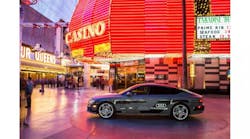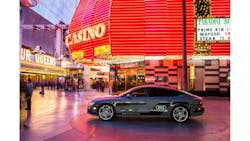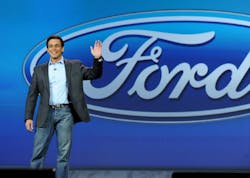To show off the capabilities of its “piloted driving concept” vehicle [that’s a longer-winded way of saying “driverless car”] at the 2015 International Consumer Electronics Show (CES), Audi sent a select group of journalists (which didn’t include me, sad to say) on a 560-mile test drive from Silicon Valley, CA, to Las Vegas, NV, where CES held its annual gathering this year.
Audi’s A7 3.0 TFSI “piloted driving” Quattro used a host of sensor arrays not only to stay in its lane at highway speeds – we’re talking 70 mph here by the way – but actually change lanes and maneuver around other vehicles.
Here’s just a short rundown on some of sensor systems involved on the “piloted” A7:
- Adaptive cruise control (ACC) and Audi side assist (ASA) long-range radar sensors;
- Mid-range radar sensors at the front and the rear of the vehicle directed to the left and right to provide the vehicle with a 360 degree view of its environment;
- Laser scanners integrated into the front single-frame grille as well the rear bumper to provide additional detailed recognition of static or dynamic objects;
- Redundant sensor data arrays including what’s called a “continuous plausibility check” during piloted driving to ensure the correct decisions are being made the vehicle and the driver;
- Four smaller cameras set at the front and rear of the vehicle to gather short-range information of the surrounding environment.
- A high-resolution wide-angle 3D video camera for observing traffic surrounding the vehicle.
They noted that before initiating a lane change to the left or the right, the piloted A7 first adapts its speed to surrounding vehicles and – if the speed and distance calculation is deemed safe – the vehicle goes ahead and initiates the lane change in what the engineers describe as “a timely manner.”
Yet Audi stressed that this “autopilot” technology has its limits, especially in city driving, and it calculates such limits on its own as well.
Therefore the system will turn vehicle operation back over to the human driver via an array of warning signals: flashing colored light emitting diodes (LEDs) at the base of the windshield, signaling the driver via the information display, posting what the engineers call a “central status indicator” or “CSI,” as well as sounding an acoustic warning indicating the driver must retake vehicle control.This is part of what Mark Fields (at left), president and CEO of Ford Motor Co., dubbed at CES the need to create an “all-new model of transportation and mobility” for the world over the next decade.
“Even as we showcase connected cars and share our plans for autonomous vehicles, we are here at CES with a higher purpose,” he explained.
“We see a world where vehicles talk to one another, drivers and vehicles communicate with the city infrastructure to relieve congestion, and people routinely share vehicles or multiple forms of transportation for their daily commute,” Fields stressed. “Ultimately, [we plan] to change the way the world moves just as our founder Henry Ford did 111 years ago.”
To that end, he said a new Ford Smart Mobility plan is engaging in 25 different “mobility experiments” around the world to test out new connectivity, mobility, autonomous vehicle, and big data technologies.
Eight of those “experiments” will be conducted in North America, nine in Europe and Africa, seven in Asia and one in South America, he explained, with each one designed to anticipate what customers will want and need in tomorrow’s transportation ecosystem.
“Challenges include finding technology solutions to identify open parking spaces in urban areas, better ways to navigate crowded cities and the use of navigation and other tools to help people gain access to medical care in remote areas,” Fields noted.
Some 14 of the 25 experiments are Ford-led research projects, with the other 11 part of the company’s “Innovate Mobility Challenge Series.” Those experiments include:
- Big Data Drive: Dearborn, MI
- Fleet Insights: U.S.
- Data Driven Insurance: London
- Remote Repositioning: Atlanta, GA
- City Driving On-Demand: London
- Dynamic Social Shuttle: New York & London
- Car Swap: Dearborn, I
- Ford Car-sharing: Germany
- Share-Car: Bangalore, India
- Rapid Recharge & Share: Dearborn, MI
- Data Driven Healthcare: Gambia, West Africa
- Parking Spotter: Atlanta, GA
- Info Cycle: Palo Alto, CA
- Painless Parking: London
“We’re already manufacturing and selling semi-autonomous vehicles that use software and sensors to steer into both parallel and perpendicular parking spaces, adjust speed based on traffic flow or apply the brakes in an emergency,” Nair (at right) added. “There will be a Ford autonomous vehicle in the future, and we take putting one on the road very seriously.”
He explained that some of the “semi-autonomous” vehicle features available today include lane-keeping assist, adaptive cruise control, Pre-Collision Assist with Pedestrian Detection and active park assist – with Traffic Jam Assist coming.
A fully autonomous Ford Fusion Hybrid research vehicle is undergoing road testing, Nair emphasized, with the vehicle using the same semi-autonomous technology available today while adding four LiDAR [light detection and ranging] sensors to generate a real-time 3D map of the surrounding environment.
The vehicle can sense objects around it using the LiDAR sensors, and uses advanced algorithms to help it learn to predict where vehicles and pedestrians might move, Nair noted.
It’ll be interesting to see how consumers react to such fully autonomous technology when it starts reaching dealer showroom floors.






